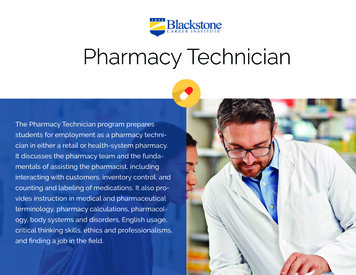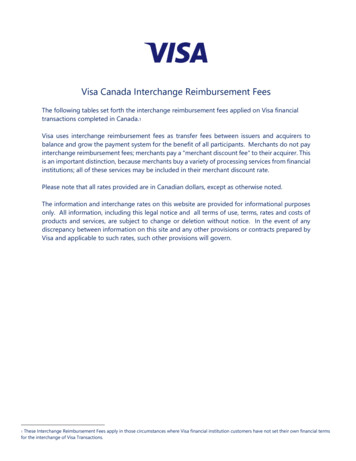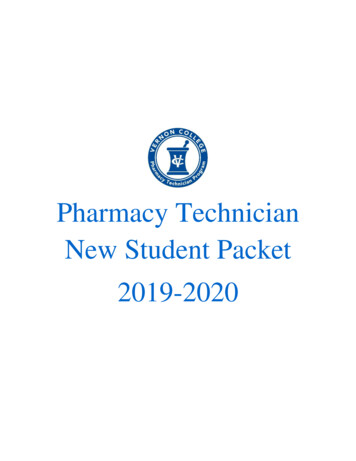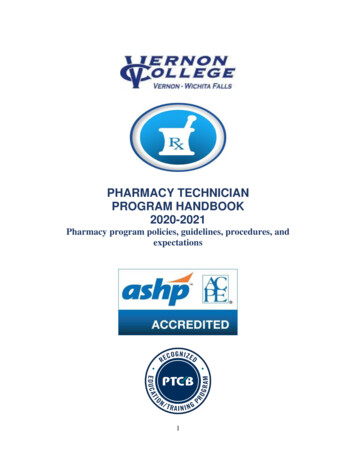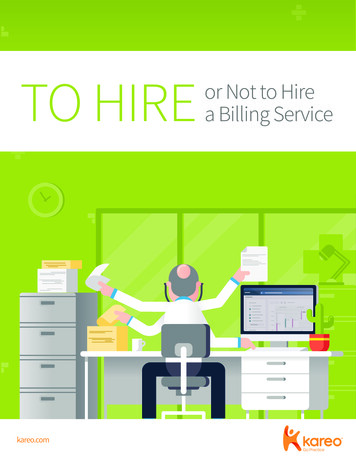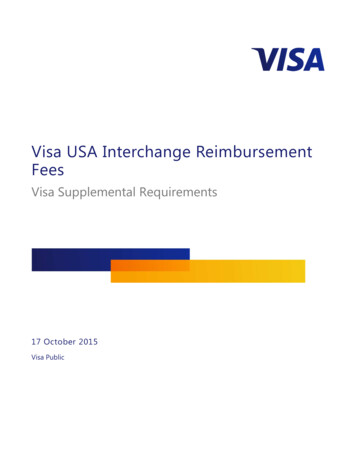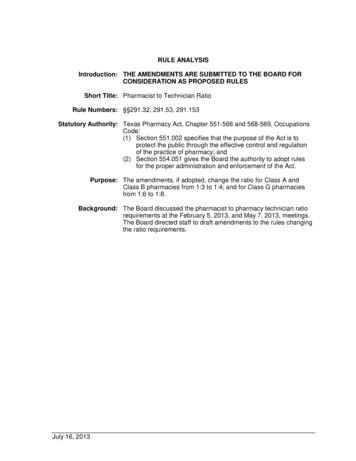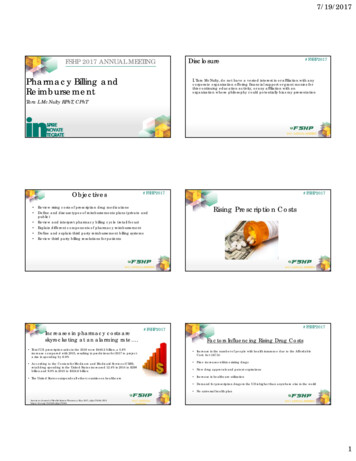
Transcription
7/19/2017FSHP 2017 ANNUAL MEETINGPharmacy Billing andReimbursementDisclosure#FSHP2017I, Tara McNulty, do not have a vested interest in or affiliation with anycorporate organization offering financial support or grant monies forthis continuing education activity, or any affiliation with anorganization whose philosophy could potentially bias my presentationTara L McNulty RPhT, CPhT2017 ANNUAL MEETING#FSHP2017Objectives Review rising costs of prescription drug medications Define and discuss types of reimbursements plans (private andpublic) Review and interpret pharmacy billing cycle (retail focus) Explain different components of pharmacy reimbursement Define and explain third party reimbursement billing systems Review third party billing resolutions for patients#FSHP2017Rising Prescription Costs2017 ANNUAL MEETINGIncreases in pharmacy costs areskyrocketing at an alarming rate .2017 ANNUAL MEETING#FSHP2017#FSHP2017 Total U.S. prescription sales in the 2016 were 448.2 billion, a 5.8%increase compared with 2015, resulting in predictions for 2017 to projecta rise in spending by 6-8%Factors Influencing Rising Drug Costs Increase in the number of people with health insurance due to the AffordableCare Act (ACA) According to the Centers for Medicare and Medicaid Services (CMS),retail drug spending in the United States increased 12.4% in 2014 to 298billion and 9.0% in 2015 to 324.6 billion Price increases within existing drugs New drug approvals and patent expirations The United States outspends all other countries on healthcare Increase in healthcare utilization Demand for prescription drugs in the U.S is higher than anywhere else in the world No universal health planAmerican Journal of Health-System Pharmacy May 2017, ajhp170164; DOI:https://doi.org/10.2146/ajhp1701642017 ANNUALMEETING2017 ANNUAL MEETING1
7/19/2017#FSHP2017#FSHP2017Pharmacy Billing BasicsHealth PlansPharmacy billing is comprised of three different categories. Knowing andunderstanding these three groups is imperative in terms ofbilling/reimbursement for the pharmacy and the patient.3 Pharmacy billing categories by health plan Private Public Cash2017 ANNUAL MEETING#FSHP2017Private Health PlansPrivate health plans are offered through commercial insurancecompanies and also may be purchased through a group orindividual. Private health plans include the following:2017 ANNUAL MEETINGPublic Health PlansPublic health care is classified as “government sponsored” andprovide coverage for low income(family/children) and senior citizenswho meet required eligibility requirements. Public health care plansinclude the following:Fee for Service Plans HMO’s (Health Maintenance Organizations) PPO’s (Preferred Provider Organizations) EPO’s (Exclusive Provider Organizations) Long term care and home health coverage availableCharacteristics of these plans Monitor how providers are treating patients Part of a “network” Provide lower health care costs Providers receive payment for services rendered2017 ANNUAL MEETINGMedicaid Government sponsored program for people of all ages with lowincome Overseen by Centers for Medicare and Medicaid Services Funded by the state and federal government, but managed bythe state Recipients must be U.S Citizens or legal residents Part of a “network” Provide lower health care costs2017 ANNUAL MEETING#FSHP2017Public Health Plans (cont.)Medicare National social insurance that guarantees health insurance for Americans65 and older, and younger people with disabilities, end stage renaldisease and ALS. Overseen by Centers for Medicare and Medicaid Services Offers a defined benefit-covers some medical costs but not all Consists of 4 parts Part A- Hospital Insurance Part B-Medical Insurance Part C-Medicare Advantage Plan-coverage for Part A and B through aprivate health plan-HMO,PPO Part D- helps to cover some prescription costs Additional insurance to groups including children and pregnant women,military veterans( Veterans Health Administration), families of militarypersonnel(TRICARE), and native Americans (Indian Health Service)2017 ANNUAL MEETINGPharmacy Billing andReimbursement2017 ANNUAL MEETING2
7/19/2017#FSHP2017Pharmacy Billing ProcessPharmacy Billing and singFrom Pharmacy to the patients hand, a prescription has numerous stagesof reimbursement for not only the pharmacy, but also the patient.Understanding the life cycle of a prescription from entry to adjudicationcan be complicated, but is the key to understanding how pharmacybilling works.#FSHP2017GatheringpatientinformationPoint ofSaleThird partyadjudicationPrescriptiondata entryPharmacyclaimprocessing2017 ANNUAL MEETING2017 ANNUAL MEETING#FSHP2017#FSHP2017Pharmacy Billing ProcessPharmacy Billing ProcessPharmacy claim submission: Prescription is sent to third party to determineapproval or denial of claim. Example below:Important processing steps:1. Tracking of the prescription (point of origin) through code- POC codes enteredthrough the pharmacy management software. Codes range from 0-4 indicatingwritten, verbal, e-prescribe, or fax2. Gathering patient insurance data including which type of coverage (primary,secondary), BIN number, group number and member ID3. Data entry steps- entering important billing information such as: Prescriber info withDEA and NPI number (national provider identifier number)4. DAW codes- entered for medication substitution if applicable5. Drug information including medication name with National Drug Code (NDC)2017 ANNUAL MEETING2017 ANNUAL MEETING#FSHP2017#FSHP2017Pharmacy Billing ProcessPharmacy claim submission: When pharmacy claim is transmitted, it does so through a switch vendor, which is avendor that ensures the information being transmitted to conform to the NationalCouncil for Prescription Drug Programs (NCPDP) standards prior to the claim reachingthe Pharmacy Benefit Manger (PBM)Pharmacy Billing ProcessDeclined submissions: The pharmacy and or the prescriber will need to contact the PBM orthe third party payer to receive approvalCommon Reasons for rejected claims: Non covered medication requiring Prior Authorization Incorrect days supply Refill too soon Invalid quantity Incorrect insurance information2017 ANNUAL MEETING2017 ANNUAL MEETING3
7/19/2017#FSHP2017#FSHP2017Pharmacy Billing ProcessPharmacy ReimbursementAdjudication: When a script is accepted, claim is then adjudicated by the payor and crossreferences the patient insurance benefits for coverage and indicates what thepatient will owe for the prescription. This process is done electronically andimmediate.Pharmacy reimbursement is the “behind the scenes” componentof processing a patients prescription. Let’s explore some of theways pharmacies get reimbursed .Retail Pharmacy Example: Pharmacies enter into an agreement /contract with a PBM and a rate/formulais set for dispensing brands, generics, and specialty medicationsPatient Pick Up-Point of Sale: Usually rate for brand and specialty dispensing is Average Wholesale Price(AWP) less a set % plus a dispensing fee Generics rates typically are a fixed amount called MAC (Maximum AllowableCost) that is the maximum amount that the plan will pay for a genericmedication MAC can be adjusted as prices lower2017 ANNUAL MEETING2017 ANNUAL MEETING#FSHP2017#FSHP2017Pharmacy Reimbursement: How they get paidPharmacies get reimbursed depending on what medications are dispersed andwhat plan the medications are originating from.Health Planmember isonReimbursement TypePharmacy Reimbursement: How they get paidReimbursementTermsDefinitionsMedicarePart D sponsors (health plans) independently negotiates pharmacy reimbursementand price concessions with manufacturers and pharmaciesNegotiatedRateMedicaidState Medicaid agencies administer Medicaid and reimburse pharmacies for drugs.States, in conjunction with the Federal Government, determine pharmacyreimbursement under broad Federal guidelines. States also receive federallymandated Medicaid drug rebates and may negotiate with manufacturers foradditional fundsIngredient CostBased on the average wholesale price (AWP) discounted by a specifiedpercentage or maximum allowable cost set by the plan sponsorsDispensing FeesCompensates the pharmacy for processing the prescription and coversexpenses such as overhead, stocking and storing medicationsPrivateConsist of ingredient cost, dispensing fee, and sales tax.Usually base reimbursement formula on AWP. PBM negotiates reimbursement withdispensing fees individually with pharmacies that is usually 40% off the usualdispensing fee charge2017 ANNUAL MEETING#FSHP2017Pharmacy Reimbursement: Rebates/DiscountPrograms2017 ANNUAL MEETING#FSHP2017Pharmacy Third Party ResolutionsOther ways pharmacies receive payment is through Rebates andDiscount programs. Manufacturers/ drug companies negotiate with payors (Medicaid, Medicare, andprivate health plan PBM’s) to pay rebates after a medication has been dispensed Rebates from drug manufactures provide reimbursement and profit to thepharmacy. In 2014, Medicaid spent approximately 42 billion on prescription drugsand collected about 20 billion in rebates Patient discount or coupons for medications are provided for high dollar or specialtymedications- this aids the pharmacy in dispensing and adjudication of these usuallyvery costly medications2017 ANNUAL MEETING2017 ANNUAL MEETING4
7/19/2017#FSHP2017Patient View Point of Pharmacy Billing Issues#FSHP2017Patient View Point of Pharmacy Billing IssuesLets review from a patient perspective a possible billing issue whileprocessing a claim .Prior ocesses theclaim throughthe PBMClaim willeither pay orreject basedon themembersbenefitsMedicationsor approvedmedicationsadjudicateand themember paysdesignatedco-payIf themedicationrejects it mayneed a priorauthorizationto adjudicateA coveragedeterminationmay bereceived bythe pharmacy2017 ANNUAL MEETINGPrior authorization (PA) are a requirement that the prescribermay need to obtain approval from a health insurance plan toprescribe a specific medication. PA is a technique forminimizing costs, wherein benefits are only paid if the medicalcare has been pre-approved by the insurance company. Thisis usually the case for very expensive medicationsReasons for Prior Authorizations Expensive or 4th tier medications Brand name medicines that areavailable in a generic form Drugs prescribed to treat a non-lifethreatening medical condition, suchas erectile dysfunction drugs Drugs that are usually covered by theinsurance company but are beingused at doses higher than normal. Off label use2017 ANNUAL MEETING#FSHP2017Patient View Point of Pharmacy Billing IssuesDepending on what type of insurance a patient is enrolled in willdetermine how the patient can resolve an issue with a non-covered,needed medication. For Medicare patients see the below process:Request a CoverageDetermination or anException frominsurance companyStandard requestsmust be replied topatient by ins compwithin 72 hoursExpedited requestsmust be respondedto within 24 hours#FSHP2017Patient View Point of Pharmacy Billing IssuesMedicare Appeals Process: There are 5 steps after an initial denial(coverage determination)from the insurance company that may takeplace to substantiate a patients or providers request for a particular noncovered medication.1. Level 1: Redetermination from plan (Appeal)-can be for any denied coveragedetermination request stemming from Formulary exceptions, tiering exceptions,and request for member reimbursements2. Level 2: Review by Independent Review Entity (IRE)3. Level 3: Hearing by Administrative Law Judge (ALJ)4. Level 4: Review by Medicare Appeals Council (Appeals Council)5. Level 5: Judicial Review by Federal District Court2017 ANNUAL MEETING2017 ANNUAL MEETING#FSHP2017Patient View Point of Pharmacy Billing Issues#FSHP2017Patient View Point of Pharmacy Billing IssuesMedicaid Recipients:Private Health Plan Patients: Medicaid patients must be prescribed medications from the PreferredDrug List (PDL) approved by the state. There is only preferred or nonpreferred options. Medications through private health plans are listed through theplans Formulary Drug list. Drugs not listed are non-preferred drugs Non-preferred medications will always require a CoverageDetermination request Prescribing physician must prove that the “formulary” medicationshave already been tried and are not effective in treatment for thepatient A prior authorization request form must be submitted In most cases, an alternative medication is suggested or cash pay isthe only option2017 ANNUAL MEETING2017 ANNUAL MEETING5
7/19/2017#FSHP2017Questions?FSHP 2017 ANNUAL MEETINGReferences1. American Journal of Health-System Pharmacy May 2017, ajhp170164; DOI:https://doi.org/10.2146/ajhp1701642. American Journal of Health-System Pharmacy July 2016, 73 (14) 1058-1075; DOI:https://doi.org/10.2146/ajhp1602053. Baltazar , Amanda. "How to Do Pharmacy Billing." Https://www.verywell.com. N.p., 13Apr. 2017. Web. 15 May 2017. -2663842 .4. Williams, Sean . "The Average American Spends This Much on Prescription Drugs EachYear." The Montley Fool. N.p., 12 Dec. 2015. Web. 15 May 2017. aspx .2017 ANNUAL MEETINGFSHP 2017 ANNUAL MEETINGReferences6. "Understanding Health Insurance - Types of Health Insurance." WebbMD. N.p., n.d.Web. 15 May 2017. dinghealth-insurance-types-of-health-insurance#2 .7. "Maximum Allowable Cost (MAC) Pricing." AMCP. N.p., n.d. Web. 15 May 2017. http://www.amcp.org/WorkArea/DownloadAsset.aspx?id 18734 .8. "Medicaid Spending for Prescription Drugs." MACPAC (Jan 2016): n. page. Web.5. Rising Generic Drug Prices Under Congressional Investigation." Pharmacy Times. Ed.Eileen Oldfield. N.p., 29 Oct. 2014. Web. 15 May 2017. rug-prices-undercongressional-investigation .FSHP 2017 ANNUAL MEETINGPharmacy Billing andReimbursementTara L McNulty RPhT, CPhT9. Levinson, Daniel R. "COMPARING PHARMACY REIMBURSEMENT:." Department of Healthand Human Services. N.p., Feb. 2009. Web. https://oig.hhs.gov/oei/reports/oei-03-0700350.pdf .10. "Medicare Prescription Drug Appeals." Medicare.gov. N.p., n.d. Web. 15 May 2017. ge-appeals.html .6
Pharmacy Billing Basics Pharmacy billing is comprised of three different categories. Knowing and understanding these three groups is imperative in terms of billing/reimbursement for the pharmacy and the patient. 3 Pharmacy billing categories by health plan Private Public
